Nandurbar district
Nandurbar district (Marathi pronunciation: [nən̪d̪uɾbaːɾ]) is an administrative district in the northwest corner of Maharashtra state in India . On 1 July 1998 Dhule was bifurcated as two separate districts now known as Dhule and Nandurbar. Nandurbar is a tribal-dominated district, The district headquarters are located at Nandurbar city. The district occupies an area of 5955 km2 and has a population of 1,648,295 of which 16.71% were urban (as of 2011).[2]
Nandurbar district | |
|---|---|
  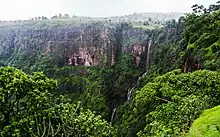 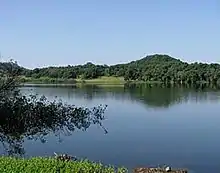 Kathi Holi, Toranmal-Nandurbar, Yeshwant Lake | |
.svg.png.webp) Location in Maharashtra | |
| Coordinates: 21°23′N 74°22′E | |
| Country | |
| State | Maharashtra |
| Division | Nashik |
| Named for | Aadivasi (tribal) |
| Headquarters | Nandurbar |
| Talukas | |
| Government | |
| • Body | Nandurbar Zilla Parishad |
| • Guardian Minister | Anil Bhaidas Patil (Cabinet Minister) |
| • President Zilla Parishad |
|
| • District Collector |
|
| • CEO Zilla Parishad |
|
| • MPs | |
| Area | |
| • Total | 5,955 km2 (2,299 sq mi) |
| Population (2011) | |
| • Total | 1,648,295 |
| • Density | 260/km2 (700/sq mi) |
| Language | |
| • Official | Marathi |
| • Spoken | Ahirani Aadivasi, Bhili, Gujar Pawri and various dialects of tribal language s |
| Time zone | UTC+5:30 (IST) |
| Telephone code | 91-2564 |
| ISO 3166 code | IN-MH-NB |
| Vehicle registration | MH-39[1] |
| Sex ratio | 975 ♂/♀ |
| Literacy | 64.38%% |
| Website | nandurbar |
Nandurbar district is bounded to the south and south-east by Dhule district, to the west and north is the state of Gujarat, to the north and north-east is the state of Madhya Pradesh. The northern boundary of the district is defined by the great Narmada river.
Ranjana Sonawane of Tembhli village and rushil in Nandurbar district became first citizen of India to get twelve (12) digit Unique Identification on 29 September 2010. The unique identification or Aadhaar is ambitious project of the central government of India to provide unique identification to its billion plus citizens.[3]
Officer
Members of Parliament
- Heena Gavit (BJP)
(Nandurbar)
Guardian Minister
| Guardian Minister Nandurbar | |
|---|---|
| पालकमंत्री नंदुरबार | |
 Emblem of India | |
| Style | The Honourable |
| Appointer | Chief Minister of Maharashtra |
| Term length | 5 years / No time limit |
| Website | nandurbar |
list of Guardian Minister
| Name | Term of office |
|---|---|
| Girish Bapat Cabinet Minister |
31 October 2014 - 23 May 2019 |
| Ram Shinde Cabinet Minister Additional Charge |
23 May 2019- 08 November 2019 |
| Adv. Kagda Chandya Padvi Cabinet Minister |
09 January 2020 - 29 June 2022 |
| Dr.Vijaykumar Gavit Cabinet Minister |
24 September 2022 - 04 October 2023 |
| Anil Bhaidas Patil Cabinet Minister |
04 October 2023 - Incumbent |
District Magistrate/Collector
| District Magistrate / Collector Nandurbar | |
|---|---|
| जिल्हाधिकारी तथा जिल्हदंडाधिकरी नंदुरबार | |
 Emblem of India | |
Incumbent Smt.Manisha Khatri (IAS) since 2018 | |
| Residence | At Nandurbar district |
| Appointer | Government of Maharashtra |
| Term length | No time limit |
| Website | nandurbar |
list of District Magistrate / Collector
| Name | Term of office |
|---|---|
| Smt.Manisha Khatri (IAS) | 2018 - Incumbent |
Divisions
The district comprises six talukas. These talukas are Nandurbar, Navapur, Shahada, Taloda, Akkalkuwa and Akrani Mahal (also called Dhadgaon).
There is one Lok Sabha constituency in the district which is Nandurbar (ST) reserved for Scheduled Tribes. There are four Maharashtra Assembly seats namely Akkalkuwa (ST), Shahada (ST), Nandurbar (ST), Nawapur (ST).
Sakri (ST) and Shirpur (ST) assembly seats from Dhule district are also part of Nandurbar Lok Sabha seat. Nandurbar is primarily a tribal (Adiwasi) district.
History
Nandurbar is a part of Satpuda Pradesh, meaning Seven Hills Region. The district was part of the district with Dhule and Jalgaon till July 1998. The ancient name of this region is Rasika, when Nandurbar was also called Nandanagri after the name of its king Nandaraja.[4]
The district is also rich with mythological accounts of the Ramayana, where the region is referred to as 'Krushik'.
The region is linked to various rulers of the time including bhil, Chalukyas, Vartakas and Yadavas.
Prior to Mughal era, formed the southern boundary of the Tughlaq Empire.
In the Jadavrao Era Yaduvanshi rulers, Nandurbar became Part of West Khandesh in 1400s.
1400s to 1700s Shinde's became Rao of west Khandesh under Jadhavrao Rulers of Khandesh :-
The Shinde/Scindia (Sarpatils) of Khandesh.[5][6][7] Who came from Amirgarh (Present in Rajasthan) as Rao of West Khandesh in and 14th century. In past they are Rai Amirgarh and ancestors of Sindh's Royal Family. They control Khandesh from Laling fort and Dhanur & Dhule Towns. In 1600s Jadhavrao lost ruling power against Mughal but after some time later Rao Shinde recaptured Khandesh with the help of Maratha Empire. In end of 1600s they came under Maratha Empire led by Chhatrapati Sambhaji and after some year later they lost the Administrative and Ruler power against Mughal Empire led by Aurangzeb in war.
Due to its strategic location at the ends of Gujarat and Madhya Pradesh, Nandurbar kept shifting into different power regimes. After the Mughal Empire's decline, the Marathas took control of Khandesh and subsequently on 3 June 1818 the Maratha Peshwa surrendered Khandesh to the British rule.
Nandurbar had its own share in the Indian struggle for independence. It was here that during the Quit India Movement of 1942 Shirish Kumar, a mere boy of 15 years, lost his life by a gun shot. A small memorial has been erected in memory of Shirish Kumar in the square where he shed his blood.
Demographics
| Year | Pop. | ±% p.a. |
|---|---|---|
| 1901 | 191,238 | — |
| 1911 | 238,612 | +2.24% |
| 1921 | 253,399 | +0.60% |
| 1931 | 304,918 | +1.87% |
| 1941 | 360,685 | +1.69% |
| 1951 | 452,166 | +2.29% |
| 1961 | 565,958 | +2.27% |
| 1971 | 692,467 | +2.04% |
| 1981 | 848,010 | +2.05% |
| 1991 | 1,062,545 | +2.28% |
| 2001 | 1,311,709 | +2.13% |
| 2011 | 1,648,295 | +2.31% |
| source:[8] | ||
As of 2001 India census,[9] Nandurbar District had a population of 1,309,135, being 50.62% male and 49.38% female. Nandurbar District has an average literacy rate of 46.63%: male literacy is 55.11%, and female literacy is 37.93%.
According to the 2011 census Nandurbar district has a population of 1,648,295,[2] roughly equal to the nation of Guinea-Bissau[10] or the US state of Idaho.[11] This gives it a ranking of 304th in India (out of a total of 640).[2] The district has a population density of 276 inhabitants per square kilometre (710/sq mi) .[2] Its population growth rate over the decade 2001–2011 was 25.5%.[2] Nandurbar has a sex ratio of 972 females for every 1000 males,[2] and a literacy rate of 64.38%. Scheduled Castes and Scheduled Tribes make up 2.91% and 69.28% of the population respectively The Bhils form the major group in the district.[2]
| Year | Male | Female | Total Population | Change | Religion (%) | |||||||
|---|---|---|---|---|---|---|---|---|---|---|---|---|
| Hindu | Muslim | Christian | Sikhs | Buddhist | Jain | Other religions and persuasions | Religion not stated | |||||
| 2001[12] | 149514 | 144570 | 294084 | - | 89.836 | 7.640 | 0.647 | 0.082 | 0.674 | 0.741 | 0.084 | 0.295 |
| 2011[13] | 833170 | 815125 | 1648295 | 4.605 | 92.315 | 5.835 | 0.514 | 0.042 | 0.301 | 0.376 | 0.176 | 0.441 |
Languages
At the time of the 2011 Census of India, 45.45% of the population in the district spoke Bhili, 16.06% Marathi, 10.46% Khandeshi, 7.34% Pawri, 4.40% Gamit, 3.79% Urdu, 2.61% Kukna and 2.55% Hindi and 2.32% Gujarati as their first language.[14]
Aadivasi (tribal) Languages spoken include Ahirani, Gujar, a Khandeshi tongue with approximately 780,000 speakers, similar to Marathi and Bhili.[15] and Pauri Bareli, a Bhil and other tribal language with approximately 175 000 speakers, written in the Devanagari script.[16]
Transport and communication
- Total railway Lines length :90 km
- No of villages connected by road
- 12 Months :671
- Temporary :262
- Total length of the roads :4338 km
- Total length of National Highway :44 km
- Total length of State
Education
- Nandurbar District has 1354 primary schools with 4497 teachers teaching 1,59,502 students; that comes to 36 students per teacher.
- Around 257 secondary schools with 2765 teachers teaching 1,31,554 students, and no of students per teacher comes to 48.
- Government Polytechnic Nandurbar with four branches Civil Engineering, Electrical Engineering, Computer Engineering, & Mechanical Engineering with intake capacity of 60 seats each.[17]
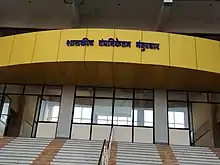
- Total colleges for higher studies, including medical and engineering, is 30, and more than 8580 students enroll each year.
- Nandurbar District also has 6 Government ITI (Industrial Training Institutes) and 2 private ITI having 1444 students in total.
- 3 VJNT Pri. School [Mhasawad, Akrale & Nandrakhe] 2 high schools, 1 junior college
- 1 SC Residential School Shahada
Places must see
- Chatrapati Shivaji Natya Gruha
At entrance a beautiful statue of Chatrapati Shivaji Maharaj
- Toranmal
It is a beautiful hill station which is around 80 km from the Nandurbar city.
Economy
In 2006 the Ministry of Panchayati Raj named Nandurbar one of the country's 250 most backward districts (out of a total of 640).[18] It is one of the twelve districts in Maharashtra currently receiving funds from the Backward Regions Grant Fund Programme (BRGF).[18]
Industries
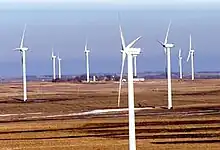
- Total Registered Factories: 346
- Total Registered & running Factories: 346
- Cooperative Sugar Factories: 3
- Total Spinning Mills: 2
- Total Cooperative Societies 1400
- Primary Agricultural Credit Societies Total: 159
- Members: 47448
- Cooperative Milk Societies: 392
Notable People
- Dr. Heena Gavit[19] (Present Member of Parliament from Nandurbar Constituency)
- Vijaykumar Gavit (Member of the Legislative Assembly from Nandurbar Constituency)
- Adv. K. C. Padavi (Member of the Legislative Assembly from Akkalkuwa Constituency)
- Rajesh Padvi (Member of the Legislative Assembly from Shahada Constituency)
- Shirishkumar Surupsing Naik (Member of the Legislative Assembly from Navapur Constituency)
- Anil Vasave[20] (First Person from Nandurbar District to climb Mount Kilimanjaro)
- Manikrao Hodlya Gavit (Former Member of Parliament from Nandurbar Constituency)
Agriculture
Climate
| Nandurbar | ||||||||||||||||||||||||||||||||||||||||||||||||||||||||||||
|---|---|---|---|---|---|---|---|---|---|---|---|---|---|---|---|---|---|---|---|---|---|---|---|---|---|---|---|---|---|---|---|---|---|---|---|---|---|---|---|---|---|---|---|---|---|---|---|---|---|---|---|---|---|---|---|---|---|---|---|---|
| Climate chart (explanation) | ||||||||||||||||||||||||||||||||||||||||||||||||||||||||||||
| ||||||||||||||||||||||||||||||||||||||||||||||||||||||||||||
| ||||||||||||||||||||||||||||||||||||||||||||||||||||||||||||
The Climate of Nandurbar District is generally Hot and Dry. As the rest of India Nandurbar District has three distinct seasons; Summer, Monsoon/Rainy and the Winter season.
Summer is from March to mid of June. Summers are usually hot and dry. During the month of May the summer is at its peak. Temperatures can be as high as 45 °C during the peak of Summer. The Monsoon sets in during the mid or end of June. During this season the weather is usually humid and hot. The northern and western regions receive more rainfall than the rest of the region. The average rainfall is 767 mm through the district.[22] Winter is from the month of November to February. Winters are mildly cold but dry.
| Seasons | Start | End |
|---|---|---|
| Summer | March | Mid June |
| Monsoon | mid June | October |
| Winter | November | February |
| Climate data for Nandurbar | |||||||||||||
|---|---|---|---|---|---|---|---|---|---|---|---|---|---|
| Month | Jan | Feb | Mar | Apr | May | Jun | Jul | Aug | Sep | Oct | Nov | Dec | Year |
| Average high °C (°F) | 25 (77) |
27 (81) |
36 (97) |
42 (108) |
43 (109) |
35 (95) |
28 (82) |
27 (81) |
30 (86) |
31 (88) |
28 (82) |
25 (77) |
31 (89) |
| Average low °C (°F) | 11 (52) |
13 (55) |
18 (64) |
22 (72) |
25 (77) |
25 (77) |
23 (73) |
22 (72) |
21 (70) |
19 (66) |
15 (59) |
12 (54) |
19 (66) |
| Average precipitation mm (inches) | 7.00 (0.28) |
1.18 (0.05) |
1.42 (0.06) |
1.79 (0.07) |
9.15 (0.36) |
108.62 (4.28) |
373.63 (14.71) |
134.91 (5.31) |
122.75 (4.83) |
40.40 (1.59) |
16.39 (0.65) |
3.49 (0.14) |
820.73 (32.33) |
| Source: [21] | |||||||||||||
Places to see
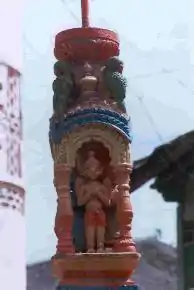
- Prakasha, one of the famous religious places, also known as Dakshin Kashi, is in Shahada Tehsil. The temple of Prakasha is very old.
- One of the famous temples of God Shree Ganesha (Heramb) is at Jainagar, 24 km away from Shahada. Hundreds of thousands of people visit this temple on the occasion of Mangli Chathurthi.
- Shri Datta temple is at Sarangkheda. Every year a big fair is organised on the eve of Datta Jayanti which has main attraction of sale of horses.
- Umaj Mata temple is at Shinda. Every year a big fair is organised on the eve of Ashatami (December).
- Hingani is a small village between Shahada and Shirpur. People there conduct the "Mahavakya" & "Mahakavya" of the Mahanubhav panth.[23]
- Dandapaneshwar, Devmogra, Nandurbar, Maharashtra
- Dev Mogra Mata is mother goddess of Adivasis. Malda-Mogra Tal Taloda is famous village related to Devi Mogra mata.
- Saint Gulam Maharaj Ranjanpur Tal Taloda is Saint of adivasi, who took away them from addiction of alcohol.
- Ashwasthama Rushi Maharaj, Valiamba, Maharashtra
- Shani Mandir, Shanimandal
- Toranmal 1076 m high peak is famous place for Navnath.
References
- "Vehicle Registration Number – Useful info for car lover". Team-BHP. Archived from the original on 1 January 2011. Retrieved 20 November 2010.
- "District Census Hand Book – Nandurbar" (PDF). Census of India. Registrar General and Census Commissioner of India.
- "Aadhar – How to get your unique ID from the govt of India". The Times of India. 29 September 2010. Retrieved 3 October 2010.
- "Archived copy" (PDF). Archived from the original (PDF) on 21 August 2021. Retrieved 11 July 2019.
{{cite web}}: CS1 maint: archived copy as title (link) - टीम, एबीपी माझा वेब (24 October 2016). "ग्रामदेवता: धुळ्याच्या साक्री तालुक्यातील श्रीधनदाई देवी". marathi.abplive.com.
- "धनदाई व पेडकाई देवी यात्रोत्सव". 12 April 2019.
- ब्युरो, साम टिव्ही. "धनदाईदेवीच्या चरणी सव्वा लाख भाविक नतमस्तक". Latest and Breaking News in Marathi | Live Marathi News Updates | live tv streaming in Marathi | Saam TV.
- Decadal Variation In Population Since 1901
- "Census of India 2001: Data from the 2001 Census, including cities, villages and towns (Provisional)". Census Commission of India. Archived from the original on 16 June 2004. Retrieved 1 November 2008.
- US Directorate of Intelligence. "Country Comparison:Population". Archived from the original on 26 December 2018. Retrieved 1 October 2011.
Guinea-Bissau 1,596,677 July 2011 est.
- "2010 Resident Population Data". U.S. Census Bureau. Archived from the original on 23 August 2011. Retrieved 30 September 2011.
Idaho 1,567,582
- Census India 2001.
- Census India 2011.
- "Table C-16 Population by Mother Tongue: Maharashtra". censusindia.gov.in. Registrar General and Census Commissioner of India.
- M. Paul Lewis, ed. (2009). "Ahirani: A language of India". Ethnologue: Languages of the World (16th ed.). Dallas, Texas: SIL International. Retrieved 28 September 2011.
- M. Paul Lewis, ed. (2009). "gujar is also indian language Bareli, Pauri: A language of India". Ethnologue: Languages of the World (16th ed.). Dallas, Texas: SIL International. Retrieved 28 September 2011.
- "G P Nandurbar". Archived from the original on 15 January 2020. Retrieved 15 January 2020.
- Ministry of Panchayati Raj (8 September 2009). "A Note on the Backward Regions Grant Fund Programme" (PDF). National Institute of Rural Development. Archived from the original (PDF) on 5 April 2012. Retrieved 27 September 2011.
- Panigrahy, Sarita; Dhar, Jay Chandra (17 February 2020). "Design of $$\text {Er}_{2}\text {O}_{3}$$-capped $$\text {SnO}_{2}$$ nanostructures using glancing angle deposition technique for enhanced photodetection". Journal of Materials Science: Materials in Electronics. 31 (6): 4780–4787. doi:10.1007/s10854-020-03035-0. ISSN 0957-4522. S2CID 213988266.
- "FIRST PERSON FROM NANDURBAR DISTRICT TO CLIMB MOUNT KILIMANJARO – High Range World Records". Retrieved 27 January 2023.
- "The Gazetteers Department – DHULIA". Maharashtra.gov.in. Retrieved 20 November 2010.
- "Special Articles – Government of Maharashtra". Maharashtra.gov.in. Retrieved 20 November 2010.
- "Hinagani". Hingani.tripod.com. Retrieved 20 November 2010.